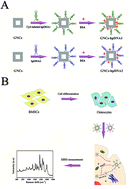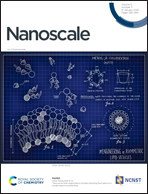Gold nanocage-based surface-enhanced Raman scattering probes for long-term monitoring of intracellular microRNA during bone marrow stem cell differentiation†
Abstract
The ability to monitor the differentiation of living stem cells is essential for understanding stem cell biology and the practical application of stem cell therapies. However, conventional methods of analyzing biomarkers related to differentiation still require a large number of cells or cell lysates. This requirement leads to the unavoidable loss of cell sources and hinders the real-time monitoring of cellular processes. In this study, we report an ultrasensitive surface-enhanced Raman scattering (SERS) method for the long-term detection and imaging of miR-144-3p in osteogenic differentiation of BMSCs, by using target miRNA-induced gold nanocage (GNC)-hairpin DNA1 (hpDNA1)-hpDNA2-GNC assembly in living cells. The finite-difference time domain method demonstrated that the electromagnetic intensities of the dimer and polymer of the GNCs were significantly enhanced compared to that of GNCs only, which theoretically confirmed the rational design of the SERS strategy. The hpDNA-conjugated GNC probes were prepared and used to recognize the target and distinguish from other miRNAs. This method enabled excellent sensitivity and high selectivity toward miR-144-3p with a limit of detection of 13.6 aM and a broad range from 100 aM to 100 pM in cell lysates. Then, we used transmission electron microscopy images, fluorescence microscopy images, and dark-field microscopy images to study the internalization of the probes in BMSCs. A Cell Counting Kit-8 experiment indicated that the probes were not cytotoxic in a certain concentration range. BMSCs were treated with an osteogenic inductor so that they would subsequently differentiate into osteocytes. Upon cellular uptake of these nanoprobes, we observed intense and time-dependent SERS responses from the important osteogenic biomarker miR-144-3p, only in BMSCs undergoing osteogenic differentiation and living undifferentiated BMSCs but not in osteoblasts. Finally, the accuracy of SERS has been proved by a quantitative real-time polymerase chain reaction experiment. The above results demonstrated that our nanoprobes are capable of long-term tracking of the dynamic expression of miR-144-3p (21 days) in the differentiating BMSCs. SERS has broad application prospects in the long-term detection of stem cell differentiation, and identification and isolation of specific cell types as well as in biomedical diagnosis.



 Please wait while we load your content...
Please wait while we load your content...